The Vespa scooter became a cultural icon during the 1960s, representing youthful freedom and stylish mobility. With its sleek design and practical appeal, it captured the spirit of a generation eager to embrace the open road. Vespas were not just a mode of transportation; they symbolized a carefree lifestyle and a break from tradition, making them a staple of urban life in cities around the world.
The Role of Vespa in Italian Cinema

Vespa scooters became iconic symbols in Italian cinema during the 1960s. The image captures two riders enjoying a ride through a charming Italian street, showcasing the scooters’ stylish design and cultural significance.
In films, the Vespa represented freedom and youthful spirit. Movies like “Roman Holiday” featured the scooter as a key element of the plot, highlighting its role in romantic escapades. The vibrant colors of the scooters, like the blue and beige seen here, added to the visual appeal of these classic films.
Riding a Vespa through narrow streets became a dream for many viewers. It symbolized a carefree lifestyle and the joy of exploring beautiful cities. The scooters were not just vehicles; they were part of the Italian identity, making them a perfect fit for the cinematic world.
Iconic Design Features of 1960s Vespas
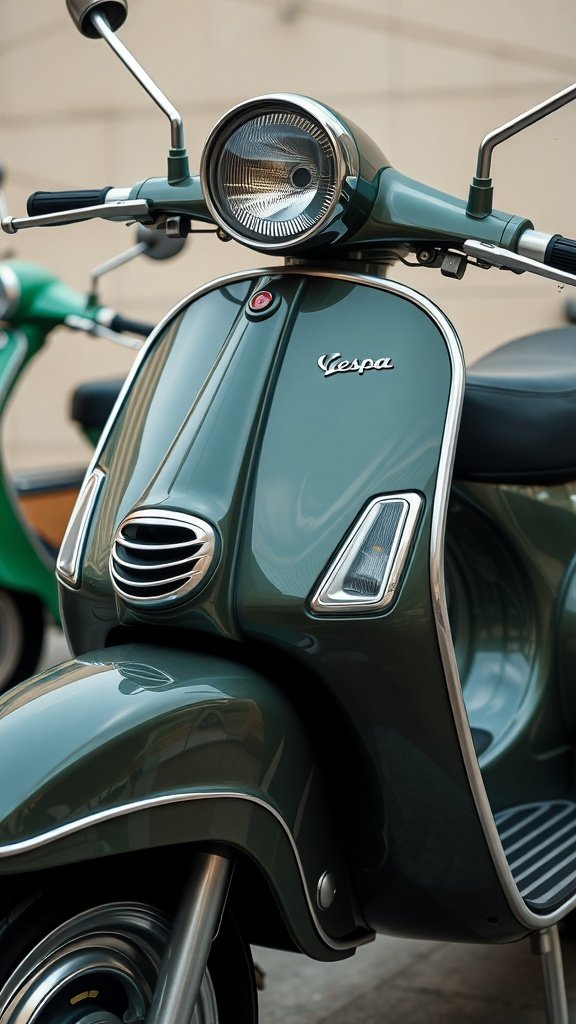
The 1960s marked a golden era for Vespa scooters, showcasing a design that was both stylish and functional. The image captures the essence of these scooters, highlighting their unique features.
The rounded body shape is a standout characteristic, giving Vespas a playful yet sophisticated look. The glossy green finish, combined with chrome accents, adds a touch of elegance. This color was popular during the era, embodying the spirit of the time.
The front of the scooter features a distinctive headlight, which not only serves a practical purpose but also enhances the overall aesthetic. The placement of the speedometer and controls is designed for easy access, making it user-friendly for riders.
Another notable feature is the protective front shield, which adds to the scooter’s charm while providing safety. The smooth lines and curves create a sense of motion, even when the scooter is stationary. These design elements made Vespa scooters a favorite among young people in the 1960s, symbolizing freedom and style.
The Rise of Vespa in Post-War Europe

The Vespa scooter became a symbol of freedom and style in post-war Europe. After World War II, many people needed affordable transportation. The Vespa filled that gap perfectly. Its unique design and compact size made it ideal for navigating narrow streets.
This image captures a classic Vespa scooter parked on a charming cobblestone street. The soft gray color of the scooter stands out against the backdrop of beautiful, historic buildings. It’s a reminder of the era when these scooters became a popular choice for young people and families alike.
Vespa scooters offered a fun and stylish way to get around. They were not just practical; they also represented a new way of life. The post-war period was all about rebuilding and moving forward, and Vespa was right there with everyone, helping them embrace this new chapter.
Scooter Rallies and Community Events

Vespa scooters were more than just a mode of transportation in the 1960s; they became a symbol of freedom and style. Scooter rallies were a big part of this culture, bringing together enthusiasts from all walks of life. These events were lively gatherings, filled with laughter, music, and, of course, plenty of Vespas.
In the image, you can see a vibrant scene at a scooter rally. People are gathered, chatting and enjoying the atmosphere. The blue Vespas stand out, showcasing their classic design. Riders are dressed casually, some wearing helmets, ready to take part in the fun. The colorful banners in the background add to the festive vibe, making it clear that this is a celebration of scooter culture.
Community events like these fostered friendships and a sense of belonging. Riders would share tips, swap stories, and even organize group rides. The camaraderie among Vespa enthusiasts was palpable, creating lasting memories and connections. These rallies were not just about the scooters; they were about the people who loved them.
Vespa and the Mod Subculture

The image captures the essence of the 1960s Mod subculture, showcasing a trio of stylish individuals on their Vespa scooters. The vibrant colors of the scooters, paired with the fashionable outfits of the riders, reflect the lively spirit of that era.
Vespa scooters became a symbol of freedom and style for the Mod community. These scooters were not just a mode of transport; they represented a lifestyle. The Mods embraced the sleek design and practicality of Vespas, making them a staple on the streets.
The scene in the photo highlights the camaraderie among friends, riding together through a bustling city. This image evokes a sense of fun and rebellion, which was central to the Mod movement. Vespas allowed young people to express their individuality and break away from traditional norms.
In the 1960s, owning a Vespa was more than just having a scooter; it was about being part of a cultural movement. The Mods used their scooters to travel to clubs, parties, and rallies, creating a vibrant social scene that still resonates today.
Vespa’s Cultural Impact in the 1960s
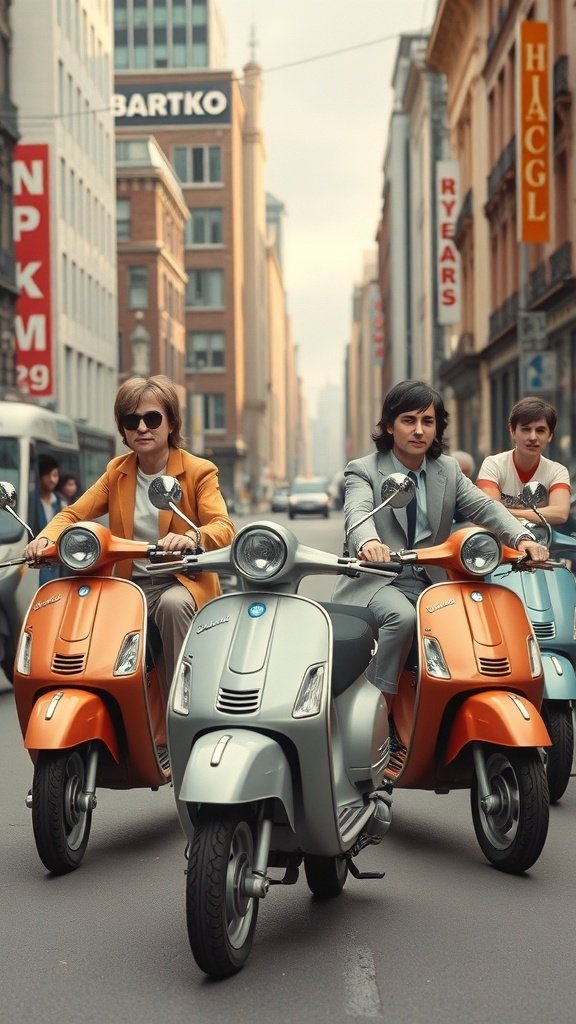
Vespa scooters became a symbol of freedom and style in the 1960s. In the image, we see a vibrant scene with riders on their colorful Vespas, showcasing the fashion and spirit of the era. The scooters are not just vehicles; they represent a lifestyle that many aspired to.
The presence of Vespa scooters in urban settings highlighted their role in everyday life. They were practical for navigating busy streets, making them popular among young people. The riders in the image, dressed in trendy outfits, reflect the youthful energy and optimism of the decade.
Vespas were often featured in films and music, further cementing their status in pop culture. They became associated with a carefree attitude, making them an icon of the 1960s. The scooters were more than just transportation; they were a way to express individuality and style.
Vespa’s Influence on Fashion Trends

The image captures a stylish woman riding a classic Vespa scooter, embodying the chic vibe of the 1960s. Her outfit, a vibrant dress paired with a tailored coat, reflects the bold fashion choices of that era. The scooter itself, with its sleek design and soft color, stands as a symbol of freedom and style.
Vespa scooters became more than just a mode of transportation; they were a fashion statement. The iconic design and colors made them a favorite among the youth. People wanted to be seen riding them, and they quickly became associated with a trendy lifestyle.
Fashion icons of the time often paired their outfits with Vespa scooters, showcasing how these vehicles complemented their looks. The combination of the scooter and stylish clothing created a unique aesthetic that many aspired to. Vespa scooters helped shape the fashion landscape, making them a must-have accessory for the fashionable crowd.
Colorful Paint Jobs of 1960s Vespas

The 1960s were a vibrant time for Vespa scooters, and their colorful paint jobs played a huge role in their popularity. Picture a sunny day, palm trees swaying, and a lineup of Vespas in stunning hues. Each scooter tells a story, reflecting the lively spirit of the era.
In the image, you can see a beautiful array of Vespas. The turquoise and soft yellow scooters stand out, showcasing the playful designs that made them beloved. The red scooter adds a bold touch, making the scene even more eye-catching. These colors weren’t just for looks; they represented freedom, youth, and a carefree lifestyle.
Riding a Vespa was more than just transportation; it was a statement. The unique paint jobs allowed riders to express their individuality. Whether cruising through city streets or enjoying a scenic ride, these scooters became symbols of style and fun.
Vespa’s Iconic Advertising Campaigns

The image captures the essence of Vespa’s charm from the 1960s. Bright orange scooters sit proudly in a vintage setting, showcasing their classic design. The warm lighting and retro decor create a nostalgic vibe that transports us back to a time when Vespa scooters were symbols of freedom and style.
Vespa’s advertising campaigns during this era were clever and captivating. They often featured young, stylish individuals enjoying life on their scooters, highlighting the fun and freedom that came with riding. The ads were not just about selling a scooter; they sold a lifestyle that many wanted to be part of.
These campaigns played a big role in making Vespa scooters iconic. They appealed to the youth of the time, showing that riding a Vespa was not just a mode of transport, but a way to express individuality and a sense of adventure. The bright colors and catchy slogans drew people in, making Vespa a household name.
Vespa and the Freedom of the Open Road

The image captures a serene moment on a sunlit road, where a rider enjoys the thrill of the open road on a Vespa scooter. The palm trees lining the street and the warm glow of the setting sun create a perfect backdrop for this iconic vehicle.
Vespa scooters became a symbol of freedom in the 1960s. They offered an easy way to navigate bustling streets and explore new places. The lightweight design and stylish look made them popular among young people seeking independence.
Riding a Vespa was not just about getting from point A to point B; it was about the experience. The wind in your hair, the feeling of freedom, and the joy of discovering hidden gems in the city were all part of the ride. This image perfectly encapsulates that spirit, showcasing how Vespa scooters transformed everyday travel into something special.
The Evolution of Vespa Models in the 1960s

The 1960s were a vibrant time for Vespa scooters, marking a significant evolution in their design and functionality. The image showcases various models that emerged during this decade, highlighting the brand’s commitment to innovation.
One standout model is the Vespa 150, which became popular for its stylish look and reliable performance. This scooter was perfect for zipping around city streets, embodying the spirit of freedom and youth that defined the era.
Another notable entry was the Vespa 180, which offered more power and speed. Riders loved the smooth handling and comfortable ride, making it a favorite among commuters. The bright colors and sleek lines of these scooters made them a fashion statement as well.
As the decade progressed, Vespa continued to adapt to changing tastes and needs. The introduction of the Vespa Primavera in 1968 brought a fresh design that appealed to a younger audience. Its lightweight frame and agile maneuverability made it a hit in urban environments.
Overall, the evolution of Vespa scooters in the 1960s reflects a blend of style and practicality. These models not only transformed transportation but also became symbols of a cultural shift, resonating with the youthful energy of the time.
Vespa’s Popularity Among Youth

Vespa scooters captured the hearts of young people in the 1960s. The image shows a lively group of friends riding their Vespas, embodying the carefree spirit of that era. These scooters were more than just a mode of transport; they represented freedom and style.
With their sleek design and vibrant colors, Vespa scooters became a symbol of youth culture. The riders in the picture are smiling and enjoying their time together, highlighting how these scooters brought friends closer. They allowed young people to explore their cities and enjoy life in a fun and fashionable way.
The 1960s was a time of change, and Vespa scooters fit perfectly into that vibe. They were easy to ride and affordable, making them accessible to many. This image captures the essence of that time, showing how Vespa scooters became a beloved choice for the youth.
The Vespa Scooter as a Symbol of Rebellion

The Vespa scooter became more than just a mode of transport in the 1960s; it transformed into a symbol of rebellion and freedom. Picture a young rider, grinning widely, cruising through city streets on a vibrant red Vespa. This image captures the essence of youthful defiance and the desire to break free from societal norms.
Vespa scooters were sleek and stylish, appealing to the youth who wanted to express their individuality. They represented a break from the past, a shift towards a more modern lifestyle. Riding a Vespa was not just about getting from point A to B; it was about making a statement.
In the backdrop of changing cultural landscapes, these scooters became a canvas for self-expression. Riders often customized their Vespas, adding personal touches that reflected their unique personalities. The scooter culture fostered a sense of community among young people, uniting them in their quest for freedom and adventure.
As the sun sets, casting a warm glow on the streets, the image of a Vespa scooter becomes a reminder of that rebellious spirit. It embodies the thrill of youth, the joy of independence, and the desire to carve out one’s own path. Riding a Vespa was, and still is, a celebration of life and freedom.
Vespa in Music and Popular Songs

The Vespa scooter became a symbol of freedom and youth in the 1960s, and its influence extended beyond the streets. Many popular songs from that era featured Vespa scooters, capturing the spirit of the time. Artists celebrated the scooter as a representation of a carefree lifestyle, often associating it with love and adventure.
In songs, the Vespa was not just a mode of transport; it was a way to express emotions and experiences. Lyrics often painted vivid pictures of young couples riding through the city, enjoying the thrill of life. The catchy tunes and upbeat rhythms made the Vespa a beloved icon in music, resonating with listeners who dreamed of cruising on their own scooters.
This connection between Vespa scooters and music helped solidify their status in popular culture. The vibrant design and ease of use made them a favorite among musicians and fans alike. As the 1960s rolled on, the Vespa became a timeless symbol of youthful rebellion and joy, forever linked to the soundtrack of a generation.
Vespa’s Role in Urban Mobility

Vespa scooters became a symbol of urban mobility in the 1960s. The image shows a lively street scene filled with various models of Vespa scooters, showcasing their popularity. These scooters were not just a means of transport; they represented freedom and style.
In crowded cities, Vespa scooters offered a practical solution for navigating traffic. Their compact size made it easy to weave through vehicles, allowing riders to reach their destinations quickly. This was especially appealing in urban areas where congestion was common.
The vibrant colors of the scooters in the image reflect the fun and youthful spirit of the era. People loved the idea of zipping around town on a stylish Vespa, making it a cultural icon. The scooters were more than just vehicles; they became a part of the lifestyle.
As cities grew and traffic increased, Vespa scooters provided an efficient way to travel. They helped shape the way people thought about commuting, making it more accessible and enjoyable. The legacy of Vespa scooters continues today, reminding us of their significant role in urban mobility.
Restoration of Vintage Vespa Scooters

Restoring a vintage Vespa scooter is a rewarding experience. These iconic scooters, popular in the 1960s, have a charm that attracts many enthusiasts. The image shows a person carefully working on a classic Vespa, highlighting the attention to detail needed in the restoration process.
First, it’s essential to assess the scooter’s condition. This includes checking the frame, engine, and electrical systems. Many restorers start by cleaning and stripping down the scooter to its bare components. This step helps identify any parts that need replacement or repair.
Next, sourcing original or compatible parts is crucial. Many vintage Vespa parts are available online or at specialty shops. Once the parts are gathered, the real fun begins. Painting the scooter in its original color or a fresh new shade can bring it back to life.
Finally, reassembling the scooter requires patience and skill. Each piece must fit perfectly to ensure the scooter runs smoothly. After the restoration, taking the Vespa for a spin is the best reward. Riding a beautifully restored Vespa is not just about transportation; it’s about enjoying a piece of history.
The Vespa Scooter in Art and Photography
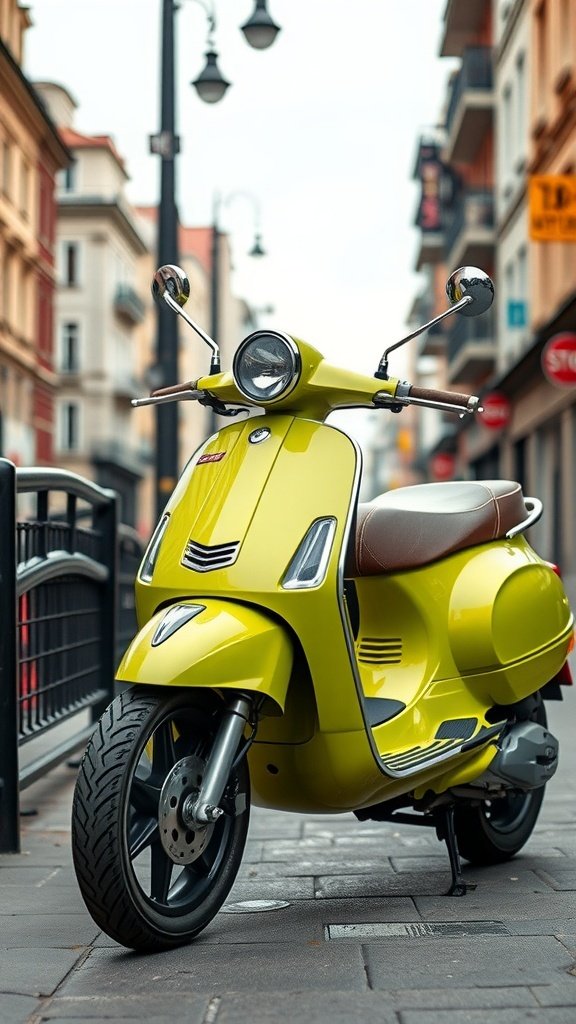
The Vespa scooter has long been a symbol of style and freedom. In the 1960s, it became a favorite subject in art and photography, capturing the essence of a vibrant era. The image of a Vespa parked on a quiet street, illuminated by warm lights, reflects its charm and timeless appeal.
Vespa scooters are often seen in urban settings, blending seamlessly with city life. The sleek design and playful colors make them stand out, yet they also fit perfectly into the backdrop of everyday scenes. This contrast is what artists and photographers love to capture.
In many photographs, the Vespa represents more than just transportation. It embodies a lifestyle filled with spontaneity and joy. The image showcases how these scooters can transform a simple street into a picturesque moment, inviting viewers to imagine their own adventures.
Overall, the Vespa scooter has left a lasting mark on art and photography. Its presence in images evokes nostalgia and a sense of freedom that continues to inspire creators today.
Vespa’s Global Expansion

The image shows a classic Vespa scooter in vibrant red, set against a colorful map of Europe. This scooter symbolizes the iconic style and freedom that Vespa Scooters brought to the streets in the 1960s.
During this time, Vespa expanded beyond Italy, capturing the hearts of many around the globe. The compact design and ease of use made it a favorite for urban commuting. People loved the idea of zipping through city streets, and Vespa made that possible.
As the brand grew, it became a symbol of youth culture and rebellion. The scooters were not just a mode of transport; they represented a lifestyle. From Paris to Rome, Vespa Scooters became a common sight, embodying the spirit of the 1960s.
This expansion was not just about selling scooters. It was about connecting with people and creating a sense of community. Vespa clubs popped up in various countries, bringing fans together to share their love for these stylish machines.
The Vespa Scooter and Travel Culture

The Vespa scooter became a symbol of freedom and style in the 1960s. This iconic vehicle was not just a mode of transport; it represented a lifestyle. People loved to ride around town, feeling the wind in their hair and the sun on their faces.
In the image, we see a sleek Vespa parked in front of stunning architecture. The mix of modern skyscrapers and classic buildings highlights how Vespa scooters fit into various urban landscapes. They were perfect for navigating busy streets and exploring new places.
Vespa scooters encouraged spontaneous trips and gatherings with friends. They made it easy to hop on and go wherever the day took you. The vibrant culture of the 1960s embraced this spirit of exploration, and the Vespa was at the heart of it all.
Vespa Accessories and Customization

The image showcases a charming display featuring classic Vespa scooters, surrounded by a variety of accessories. These scooters were iconic in the 1960s, representing freedom and style. The vibrant colors and retro design of the scooters evoke a sense of nostalgia.
Customization was a big part of the Vespa culture. Riders loved to personalize their scooters with unique accessories. From stylish helmets to colorful seat covers, every detail mattered. This allowed owners to express their individuality while cruising through the streets.
In the background, you can see various bags and vintage items that complement the Vespa lifestyle. These accessories not only added flair but also practicality for riders. Whether it was a stylish bag for carrying essentials or a cool jacket to match the scooter, the options were endless.
Vespa scooters were more than just a mode of transport; they were a canvas for creativity. Each customization told a story, making every ride a personal experience. The blend of functionality and style made these scooters a beloved choice for many.
The Sound of the Vespa Engine

The Vespa scooter is not just a stylish ride; it’s also known for its unique sound. The engine produces a distinct hum that many enthusiasts recognize instantly. This sound is part of the charm that makes Vespa scooters special.
In the 1960s, the Vespa engine’s sound became a symbol of freedom and youth. Riders loved the way it roared to life, echoing through city streets and countryside roads. It was a sound that signified adventure and a carefree spirit.
Today, that iconic sound still resonates with fans of Vespa scooters. Whether you’re cruising down a busy avenue or taking a leisurely ride through a park, the engine’s purr adds to the experience. It’s a reminder of the scooter’s rich history and its place in popular culture.
Vespa’s Connection to the Italian Lifestyle

The image captures a lively street scene where Vespa scooters are parked, showcasing their iconic design and vibrant colors. These scooters are more than just vehicles; they symbolize a carefree Italian lifestyle that flourished in the 1960s.
In the photo, people are gathered at a café, enjoying their time while the scooters stand ready for a quick getaway. This reflects how Vespa scooters are integrated into daily life, making them a popular choice for both locals and tourists. The casual vibe of the scene highlights the joy of riding a Vespa, which is often associated with freedom and exploration.
Vespa scooters became a staple of Italian culture, representing style and practicality. They are easy to maneuver through narrow streets and perfect for zipping around town. The connection between Vespa and the Italian lifestyle is undeniable, as these scooters embody the spirit of la dolce vita, making every ride feel like a mini escape.
Vespa’s Place in Modern Collecting

Vespa scooters hold a special charm that appeals to collectors today. The image shows a lineup of stylish Vespas in a showroom, showcasing their classic design and modern updates. Each scooter has its own character, reflecting the timeless appeal of the brand.
Collectors are drawn to Vespa scooters not just for their looks, but also for their history. These scooters became symbols of freedom and youth in the 1960s. Today, owning a Vespa is like having a piece of that vibrant era.
Many collectors focus on specific models, often seeking vintage versions that tell a story. The thrill of finding a rare Vespa can be exhilarating. Whether it’s a classic from the 60s or a newer model, each scooter has its own fan base.
Vespas are more than just vehicles; they represent a lifestyle. Joining a community of Vespa enthusiasts can be rewarding. Events and meet-ups allow collectors to share their passion and showcase their prized scooters.
The Vespa and Environmental Awareness
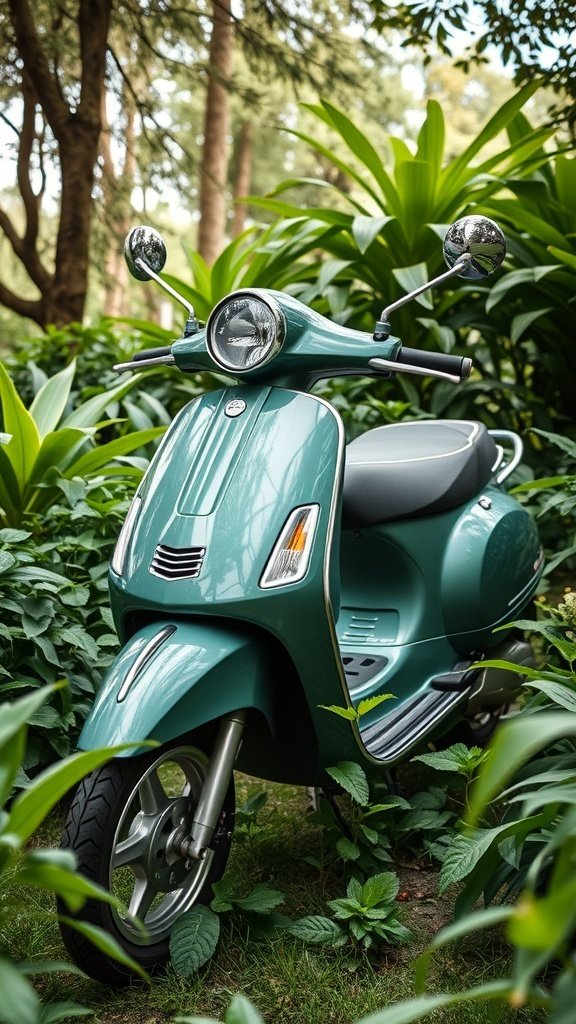
The Vespa scooter has long been a symbol of style and freedom. In the 1960s, it became more than just a mode of transport; it represented a lifestyle. The image of a classic Vespa, with its sleek lines and vibrant color, captures this essence perfectly.
As people began to care more about the environment, Vespa scooters gained popularity for their fuel efficiency. They offered a practical solution for urban commuting without the heavy carbon footprint of larger vehicles. This made them appealing to those who wanted to reduce their impact on the planet.
The design of the Vespa also plays a role in its environmental appeal. Its compact size allows for easy maneuvering through city streets, reducing traffic congestion. Fewer cars on the road mean less pollution, and the Vespa fits right into this vision of a cleaner, greener future.
In the image, the Vespa is surrounded by lush greenery, emphasizing its connection to nature. This visual reminds us that choosing a scooter can be a step towards a more sustainable lifestyle. The Vespa is not just a scooter; it’s a statement about caring for our environment while enjoying the ride.
The Legacy of Vespa in Today’s Culture
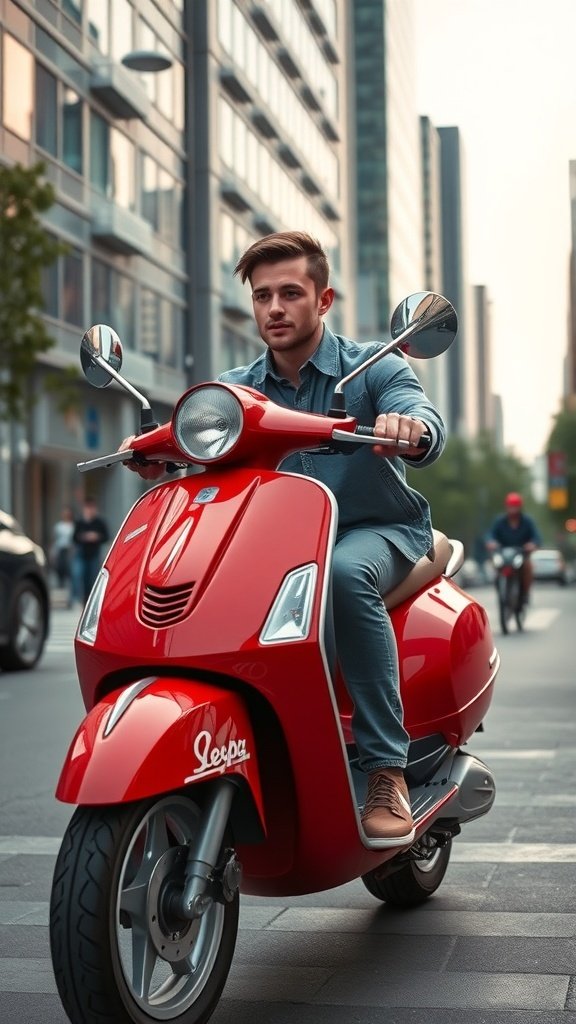
Vespa scooters have left a mark on culture that continues to thrive today. The image captures a vibrant scene filled with colorful Vespas, showcasing their popularity in urban settings. The yellow, blue, and red scooters stand out against the backdrop of tall buildings, symbolizing freedom and style.
These scooters were not just a mode of transport in the 1960s; they became icons of youth and rebellion. Today, they still evoke that same spirit. People ride Vespas for fun, practicality, and a touch of nostalgia. The sight of a Vespa zipping through city streets can bring a smile to anyone’s face.
In many cities, Vespa clubs and events celebrate this legacy. Riders gather to share their love for these scooters, creating a community that spans generations. The image reflects this ongoing passion, showing how Vespa scooters continue to be a symbol of individuality and style in modern culture.
Iconic Design and Cultural Impact
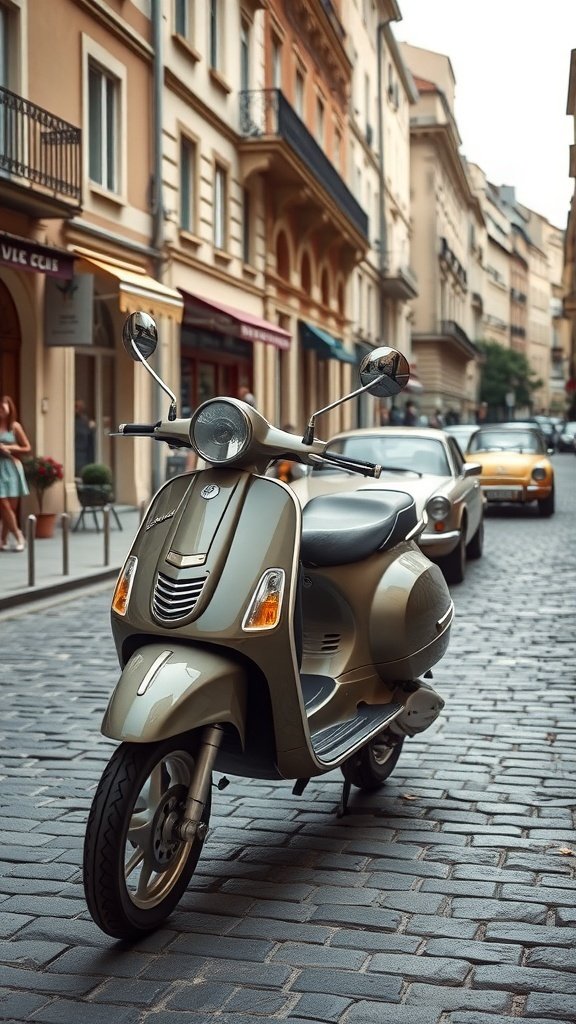
The Vespa scooter is a symbol of style and freedom that took the world by storm in the 1960s. With its sleek lines and vibrant colors, the Vespa became more than just a mode of transport; it represented a lifestyle. The image captures a classic Vespa parked on a charming cobblestone street, surrounded by beautiful architecture. This setting perfectly showcases the scooter’s elegance and its connection to urban life.
During the 1960s, Vespa scooters were seen everywhere, from the bustling streets of Rome to the scenic avenues of Paris. They were popular among young people who embraced the spirit of the time. The design was not just functional; it was fashionable. Riders loved the way they could zip around town, making a statement while enjoying the open air.
The cultural impact of Vespa scooters extended beyond their looks. They became icons of popular films and music, often associated with youth and rebellion. The image of a Vespa evokes feelings of nostalgia, reminding us of a time when life felt simpler and more carefree. Today, they still hold a special place in the hearts of many, symbolizing a blend of classic charm and modern practicality.
Vespa’s Enduring Popularity in the 21st Century
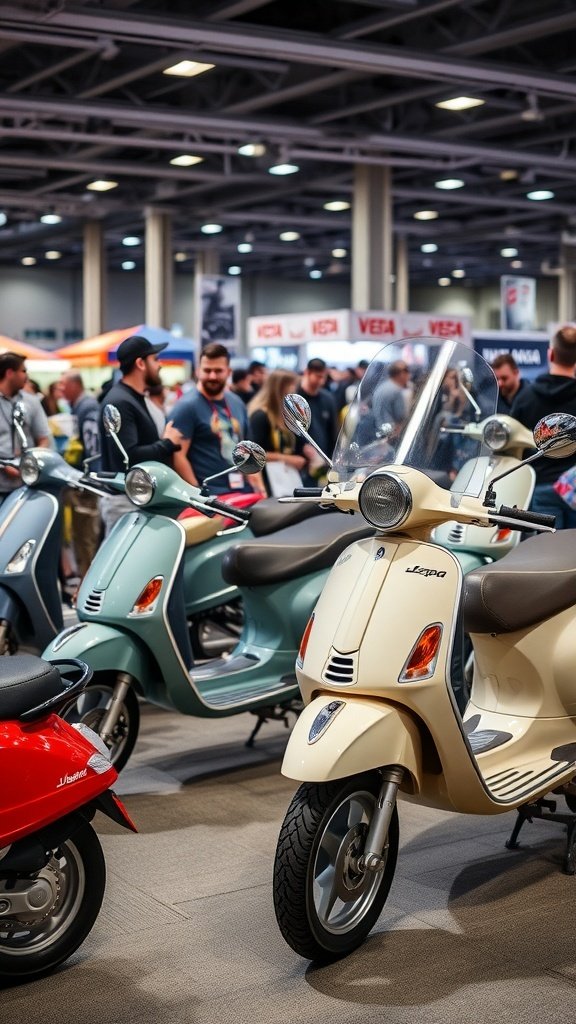
Vespa scooters have made a remarkable comeback in the 21st century. The image captures a lively scene at a scooter event, showcasing a variety of stylish Vespa models. Each scooter reflects the classic design that has charmed riders for decades.
These scooters are not just about transportation; they represent a lifestyle. The vibrant colors and sleek lines appeal to both young and old. Vespa scooters evoke a sense of freedom and fun, making them a popular choice in urban settings.
Today, many people are drawn to Vespa scooters for their eco-friendliness and ease of use. They are perfect for navigating busy streets and finding parking in crowded areas. The blend of vintage charm and modern technology keeps Vespa relevant in a fast-paced world.
With a strong community of enthusiasts, Vespa culture thrives. Events like the one in the image bring together fans who share a passion for these iconic scooters. Whether it’s a casual ride or a rally, the spirit of Vespa continues to inspire.
The Future of Vespa Inspired by the 1960s

The Vespa scooter has a rich history that dates back to the 1960s. This iconic ride symbolizes freedom and style, capturing the spirit of a generation. The image shows a modern Vespa, reflecting its classic design while embracing contemporary features.
Today, Vespa scooters continue to evolve, blending retro charm with modern technology. The vibrant red color of this scooter stands out, reminiscent of the bold styles from the past. It’s not just a mode of transport; it’s a statement piece.
As we look to the future, Vespa remains committed to sustainability. Electric models are becoming more popular, allowing riders to enjoy the classic Vespa experience while being eco-friendly. This shift shows how the brand honors its roots while adapting to new trends.
Vespa scooters are more than just vehicles; they represent a lifestyle. Whether you’re cruising through the city or enjoying a weekend getaway, these scooters offer a unique blend of nostalgia and modernity. The future looks bright for Vespa, and fans can’t wait to see what’s next!
Vespa’s Role in the Global Scooter Market

The image showcases a vibrant lineup of Vespa scooters, highlighting their iconic design and colorful appeal. In the 1960s, Vespa scooters became a symbol of style and freedom, capturing the hearts of many. The bright yellow scooter in the foreground stands out, representing the fun and youthful spirit of that era.
Vespa scooters played a significant role in the global scooter market during the 1960s. They were not just a mode of transport; they became a cultural phenomenon. With their unique design and practicality, they appealed to a wide audience, from young professionals to families.
The scooters were perfect for navigating busy city streets, making them a popular choice in urban areas. Their affordability and ease of use contributed to their widespread adoption. Vespa scooters became synonymous with the Italian lifestyle, embodying a sense of freedom and adventure.
As the 1960s progressed, Vespa expanded its reach beyond Italy, making a mark in various countries. The brand’s influence helped shape the global scooter market, setting trends that many other manufacturers followed. Today, Vespa remains a beloved brand, continuing to evoke nostalgia for a simpler, more stylish time.
Want more?
You may also like:
– 25 Retro Bathroom Decor Ideas Inspired by the 1960s
– 50 Ultimate Art-Deco Kitchens Inspired By The 1920s
– 20 Stunning Home Decor Ideas Inspired by Game of Thrones
If you enjoyed this blog you can visit us or check out our other blogs and learn a bit about us.
Disclaimer: This blog post is inspired by fictional universes and characters created by their respective rights holders. All related content and imagery remain the property of their respective rights holder. This fan-inspired content is for entertainment and commentary purposes only and is not affiliated with or endorsed by HBO, Disney, Warner Bros., Lionsgate, or any other rights holders. To explore the official source material, please visit:
HBO

